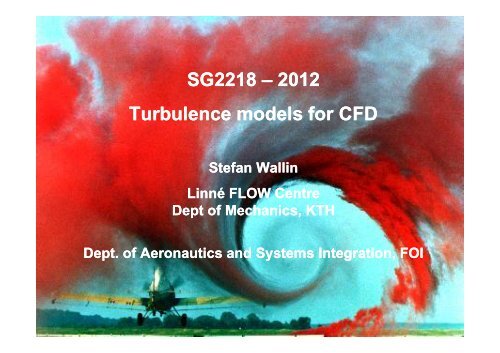SG2218 â 2012 Turbulence models for CFD SG2218 â 2012 ... - KTH
SG2218 â 2012 Turbulence models for CFD SG2218 â 2012 ... - KTH
SG2218 â 2012 Turbulence models for CFD SG2218 â 2012 ... - KTH
You also want an ePaper? Increase the reach of your titles
YUMPU automatically turns print PDFs into web optimized ePapers that Google loves.
<strong>SG2218</strong> – <strong>2012</strong><br />
<strong>Turbulence</strong> <strong>models</strong> <strong>for</strong> <strong>CFD</strong><br />
Stefan Wallin<br />
Linné FLOW Centre<br />
Dept of Mechanics, <strong>KTH</strong><br />
Dept. of Aeronautics and Systems Integration, FOI
Last time<br />
• Boussinesq hypothesis (eddy-viscosity assumption)<br />
– Problems: history effects, alignment, rotation<br />
• Eddy-viscosity <strong>models</strong><br />
– Algebraic (zero-equation <strong>models</strong>)<br />
– One-equation <strong>models</strong> (Spalart-Allmaras)<br />
– Two-equation <strong>models</strong> (std k–, Wilcox k–, Menter SST k–)
The K – <br />
model
The K – model
The K – model – problems<br />
Unphysical influence of free stream conditions<br />
• Calibration of the Schmidt numbers<br />
• Introducing a “cross diffusion term”<br />
• Such modifications have been proposed by<br />
– Menter SST (1993)<br />
– Kok (1999)
Boundary conditions<br />
The K – model is singular at the wall<br />
• Log-law boundary conditions<br />
– Not strictly valid in separated flows<br />
• Near-wall (low-Reynolds number) corrections<br />
– Wall damping functions based on<br />
– Active up to<br />
– Near-wall grid size<br />
The K – model<br />
• No such problems – can be integrated to the wall<br />
• Near-wall grid size
Turbulent boundary layer
Modelling of production<br />
Exact: Model:<br />
• Strain rate dependency<br />
– Exact – linear dependency:<br />
– Model – quadratic dependency:<br />
• What is the consequence<br />
– No problem in equilibrium flows<br />
– Stagnation flows: turbulence overpredicted -> e.g. heat<br />
transfer in stagnation regions<br />
– Separated flows: turbulence overpredicted -> separation<br />
size typically underpredicted<br />
• How to improve: Menter SST<br />
– Limit turbulence viscosity
Example – stagnation flow<br />
Flow around a wing profile – leading edge<br />
• <strong>Turbulence</strong> kinetic energy shown<br />
• Std. Eddy-viscosity <strong>models</strong> – excessive production of K<br />
• Cured by ”SST”<br />
Std. k-<br />
SST k-
Rotation and flow curvature<br />
• Eddy-viscosity model<br />
e.g. std K-eps model<br />
• Dependent on<br />
– Symmetric part of<br />
velocity gradient<br />
– Invariant of rotation<br />
• No dependence on<br />
Thus:<br />
• No model influence on rotation, swirl, or flow curvature<br />
– But turbulence is very dependent<br />
• Empirical “fixes”: Different rotation corrections
Rotating turbulent channel<br />
Increasing rotation rate
Milestone – Eddy-viscosity <strong>models</strong> (EVM)<br />
• 0- and 1-eq <strong>models</strong> – incomplete (additional in<strong>for</strong>mation needed)<br />
• 2-eq <strong>models</strong> (K-)<br />
•Based on N-S equations<br />
•Model coefficients by calibration/analysis of generic flows<br />
• Popular eddy-viscosity <strong>models</strong> (EVM):<br />
– Spalart-Allmaras 1-eq model<br />
– Menter SST K- model<br />
• Good <strong>for</strong>:<br />
– Attached thin boundary layers<br />
– Mainly 2D flows<br />
• EVMs in general not good <strong>for</strong>:<br />
– Non-equilibrium flow<br />
– Swirl, rotation and flow curvature<br />
– Boundary layer separation<br />
• There are fixes …<br />
• A better way is to get rid of the eddy-viscosity assumption<br />
–> Reynolds stress <strong>models</strong>
Reynolds stress <strong>models</strong> (RST or DRSM)<br />
• Reynolds stress equation<br />
• Advection by the mean flow (exact) = Transported by the mean flow<br />
• Production (exact) = of energy, taken from mean flow<br />
or
Reynolds stress <strong>models</strong> …<br />
• Pressure-strain rate (model) = Redistribution among components<br />
– LRR: Launder, Reece & Rodi (1975)<br />
– SSG: Speziale, Sarkar & Gatski (1991)<br />
• Dissipation rate (isotropic) = Viscous dissipation into heat<br />
– Plus equation <strong>for</strong><br />
• Turbulent flux = Redistribution in space<br />
– Gradient diffusion<br />
– Daly & Harlow (GGD)

















